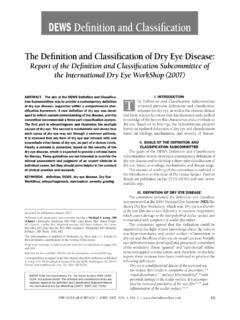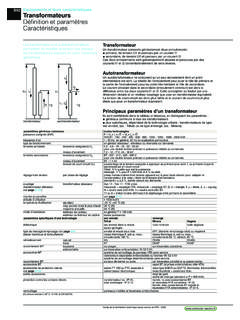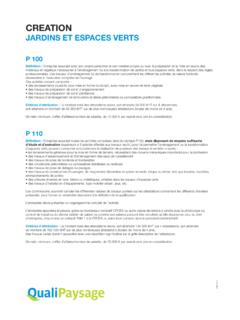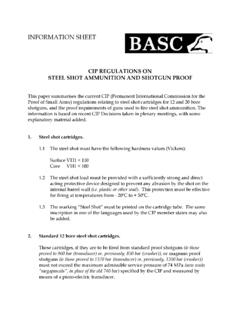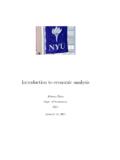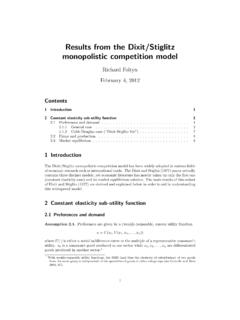Transcription of 1 Lecture 3: Operators in Quantum Mechanics - …
1 1 Lecture3: Operatorsin thepreviouslectureswe have metoperators:^xand^p= i hrtheyarecalled\fundamentaloperators".Ma ny operatorsareconstructedfrom^xand^p; forexampletheHamiltonianfora singleparticle:^H=^p22m+^V(^x)where^p2=2 mis ^Vis canaddoperatorsto geta askwhatotheralgebraicoperationsonecancar ryoutwithoperators?Theproductof two operatorsis de nedby operatingwiththemona ^Aand^B, andletusoperateona functionf(x) (one-dimensionalforsimplicity of notation).Thentheexpression^A^Bf(x)is a canthereforesay, by thede nitionof Operators ,that^A^Bis anoperatorwhich we candenoteby^C:^Cis theproductof Operators ^Aand^ ^A^Bf(x) shouldbe that^Bis rstoperatingonf(x), givinga newfunction,andthen^Ais :^A= ^xand^B= ^p= i hd=dx, thenwe have^A^Bf(x) = ^x^pf(x)We canof coursealsoconstructanothernewoperator:^p ^xThen,by de nitionof theoperatorproduct,^p^xf(x)meansthat^xis rstoperatingonf(x) andthen^pis operatingonthefunction^xf(x).
2 Comparetheresultsof operatingwiththeproducts^p^xand^x^ponf(x ):(^x^p ^p^x)f(x) = i h xdf(x)dx ddx(xf(x))!andhenceby theproductruleof di erentiation:(^x^p ^p^x)f(x) =i hf(x)1andsincethismustholdforany di erentiablefunctionf(x), we canwritethisas anoperatorequation:^x^p ^p^x=i hThus we have shownthattheoperatorproductof ^xand^ operatorsof theform^A^B ^B^Adofrequentlyarisein QMcalculations,it is customaryto usea short-handnotation:[^A;^B] ^A^B ^B^Aandthisis calledthecommutatorof^Aand^B(in thatorder!).If [^A;^B]6= 0, thenonesays that^Aand^Bdonotcommute,if [^A;^B] = 0, then^Aand^Baresaidto commutewitheach theformof[^A;^B] = somethingis calledacommutationrelation.
3 [^x;^p] =i his eigenvaluesof have repeatedlysaidthatanoperatoris de nedto be a mathematicalsymbol thatappliedto a functiongives a if we have a functionf(x) andanoperator^A, then^Af(x)is a somenewfunction,say (x).Exceptionallythefunctionf(x) may be such that (x) is proportionaltof(x); thenwehave^Af(x) =af(x)whereais someconstant of proportionality. In thiscasef(x) is calledaneigenfunctionof^ :Considerthefunctionf(x;t) =ei(kx !t).Thisrepresents a wave (x) withthemomentumoperator:^pf(x) = i hddxf(x) = ( i h)(ik)ei(kx !t)= hkf(x)andsinceby thedeBroglierelation hkis themomentumpof theparticle,we have^pf(x) =pf(x)Notethatthisexplainsthechoiceof signin thede nitionof themomentumoperator!
4 ^Ais saidto be linearif^A(cf(x))=c^Af(x)and^A(f(x) +g(x))=^Af(x) +^Ag(x)wheref(x) andg(x) areany two appropriatefunctionsandcis a :theoperators^x, ^pand^ checkedby explicitcalculation(Exercise!). ^Ayis calledthehermitianconjugateof^AifZ ^Ay dx=Z ^A dxNote:anothernamefor\hermitianconjugate "is \adjoint".Theoperator^Ais calledhermitianifZ ^A dx=Z ^A dxExamples:(i)theoperator^xis :Z(^x ) dx=Z(x ) dx=Z x dx=Z ^x dx(ii)theoperator^p= i hd=dxis hermitian:Z(^p ) dx=Z i hd dx! dx=i hZ d dx! dxandafterintegrationby parts,andrecognizingthatthewfntendsto zeroasx!
5 1, we getontheright-handside i hZ d dxdx=Z ^p dx(iii) ^T= ^p2=2mis hermitian:Z ^T dx=12mZ ^p2 dx=12mZ(^p ) ^p dx=12mZ ^p2 dx=Z ^T dx3(iv)theHamiltonianis hermitian:^H=^T+^V(^x)here^Vis a hermitianoperatorby virtueof beinga functionof thehermitianoperator^x, andsince^Thasbeenshownto be hermitian,so^His :Theeigenvaluesof :Let be aneigenfunctionof^Awitheigenvaluea:^A =a thenwe haveZ ^A dx=Z(a ) dx=a Z dxandby hermiticity of^Awe alsohaveZ ^A dx=Z ^A dx=aZ dxhence(a a)Z dx= 0andsinceR dx6= 0, we geta a= 0 Theconversetheoremalsoholds:anoperatoris hermitianif is leftas :by virtueof theabove theoremsonecande nea hermitianoperatoras.
6 Theeigenvaluesof theHamiltonianare fact,sinceby de nitiontheHamiltonianhasthedimensionof energy, thereforetheeigen-valuesof theHamiltonianaretheenergiesof thesystemdescribedby thewave systemof particleswithwave function (x)(xcanbe understood to standforalldegreesof freedomof thesystem;so,if we have a systemof two particlesthenxshouldrepresentfx1;y1;z1;x 2;y2;z2g).Theexpectationvalueof anoperator^Athatoperateson is de nedbyh^Ai Z ^A dxIf is aneigenfunctionof^Awitheigenvaluea, then,assumingthewave functionto benormalized,we haveh^Ai=a4 Now considertherateof changeof theexpectationvalueof^A:dh^Aidt=Z@@t ^A dx=Z(@ @t^A + @^A@t + ^A@ @t)dx=*@^A@t++i hZn ^H ^A ^A^H odxwherewe have usedtheSchr odingerequationi h@ @t=^H Now by hermiticity of^Hwe :i hZn ^H^A ^A^H odx=i hZ ^H^A ^A^H dxhencedh^Aidt=*@^A@t++i hh[^H.]
7 ^A]iOf particularinterestin applicationsarelinearhermitianoperatorst hatdo notexplicitlydependontime, that@^A=@t= 0 For thisclassof operatorswe getthefollowingequationof motion:i hdh^Aidt=h[^A;^H]iHeretheexpectationvalu esaretaken anoperatorequation:i hd^Adt= [^A;^H]If in particular^Ais anobservablethatcommuteswith^H, [^A;^H] = 0, thend^Adt= ^Ais a canalsoprove thefollowingtheorem:if two Operators ^Aand^Bcommute,thentheyhave :Let be aneigenfunctionof^Awitheigenvaluea:^A =a 5operatingonbothsideswith^Bwe get^B(^A ) =a^B canwrite^B^A , andthensinceby assumption^Aand^Bcommute,we get^A^B =a^B thus^B is aneigenfunctionof^Awiththesameeigenvalue as ; therefore^B candi erfrom onlyby a constant factor, musthave^B =b is alsoaneigenfunctionof^ alsotruebutnotas useful.
8 I constructedby takingthecorrespondingdynamicalvariableo f classicalmechanics,which is expressedin termsof coordinatesandmomenta,andreplacingxby ^x,pby ^ in facttheway we have we applythisprescriptionto classicalmechanicsonede nestheangularmomentumby~L=~r ~pWe gettheangularmomentumoperatorby replacingthevector~rby thevectoroperator^r= (^x;^y;^z) andthemomentumvectorby themomentumvectoroperator^p= i hr= i h(@x; @y; @z)where@x=@ thecoordinateandmomentumoperatorsare[^x; ^px] = [^y;^py] = [^z;^pz] =i hand[^x;^py] = [^x;^pz] =:::= [^z;^py] = 0It willbe convenient to usethefollowingnotation:^x1= ^x;^x2= ^y;^x3= ^zand^p1= ^px;^p2= ^py;^p3= ^pzwe canthensummarizethefundamentalcommutatio nrelationsby[^xi;^pj] =i h ijwhere ijis theKronecker symbol: ij=(1ifi=j0ifi6=j6We cannow ndthecommutationrelationsforthecomponent s of dothisit is convenient to getat rstthecommutationrelationswith^xi, thenwith^pi, and nallythecommutationrelationsforthecompon ents of considerthecommutator[^x;^Lx]: we have^Lx= ^y^pz ^z^py, andhenceby thefundamentalcommutationrelations[^x.)]
9 ^Lx] = 0 Nextconsider[^x;^Ly]: we have^Ly= ^z^px ^x^pzhence[^x;^Ly] = [^x;^z^px] [^x;^x^pz] =i h^zandsimilarly[^x;^Lz] = i h^yetc. We cansummarizetheninecommutationrelations: [^xi;^Lj] =i h"ijk^xkwhere"ijk=8> <>:1if(ijk) = (1;2;3) or (2;3;1) or (3;1;2) 1if(ijk) = (1;3;2) or (3;2;1) or (2;1;3)0ifi=jori=korj=kandsummationover therepeatedindexkis [^pi;^Lj] =i h"ijk^pkafterwhich it is straight forwardto deduce:[^Li;^Lj] =i h"ijk^LkTheimportant conclusionfromthisresultis thatthecomponentsof angularmomentumhaveno ,we mustalsoshow courseplausible(reasonable)sincewe know thattheangularmomentumis a dynamicalvariablein is leftas canconstructonemoreoperatorthatcommutesw ithall components of^L: de nethesquareof^Lby^L2=^L2x+^L2y+^L2zthen[ ^Lx;^L2] =[^Lx;^L2x+^L2y+^L2z]=[^Lx;^L2y] + [^Lx;^L2z]7 Now thereis a simpletechniqueto evaluatea commutatorlike [^Lx;^L2y]: writedownexplicitlytheknowncommutator[^L x.
10 ^Ly]:^Lx^Ly ^Ly^Lx=i h^Lzmultiplythisontheleftby^Ly, thenmultiplyontheright by^Ly:^Ly^Lx^Ly ^L2y^Lx=i h^Ly^Lz^Lx^L2y ^Ly^Lx^Ly=i h^Lz^Lyandif we addthesecommutationrelationswe get^Lx^L2y ^L2y^Lx=i h(^Ly^Lz+^Lz^Ly)andsimilarly^Lx^L2z ^L2z^Lx= i h(^Ly^Lz+^Lz^Ly)hence[^Lx;^L2] = 0andsimilarly[^Ly;^L2] = [^Lz;^L2] = 0 Finallyonecanalsoshow thatthecomponents of^Land^L2commutewith^p2, ^T, andthattheycommutewithrandhencewithany is mosteasilyshownby workingin sphericalpolarcoordinates(r; ;'),where is thepolarangleand' we choosethepolaraxisalongthecartesianzdire ction,thenwe getaftersometediouscalculationthefollowi ngexpressionsfortheangularmomentumcompon ents:^Lx=i h sin'@@ + cot cos'@@'!
